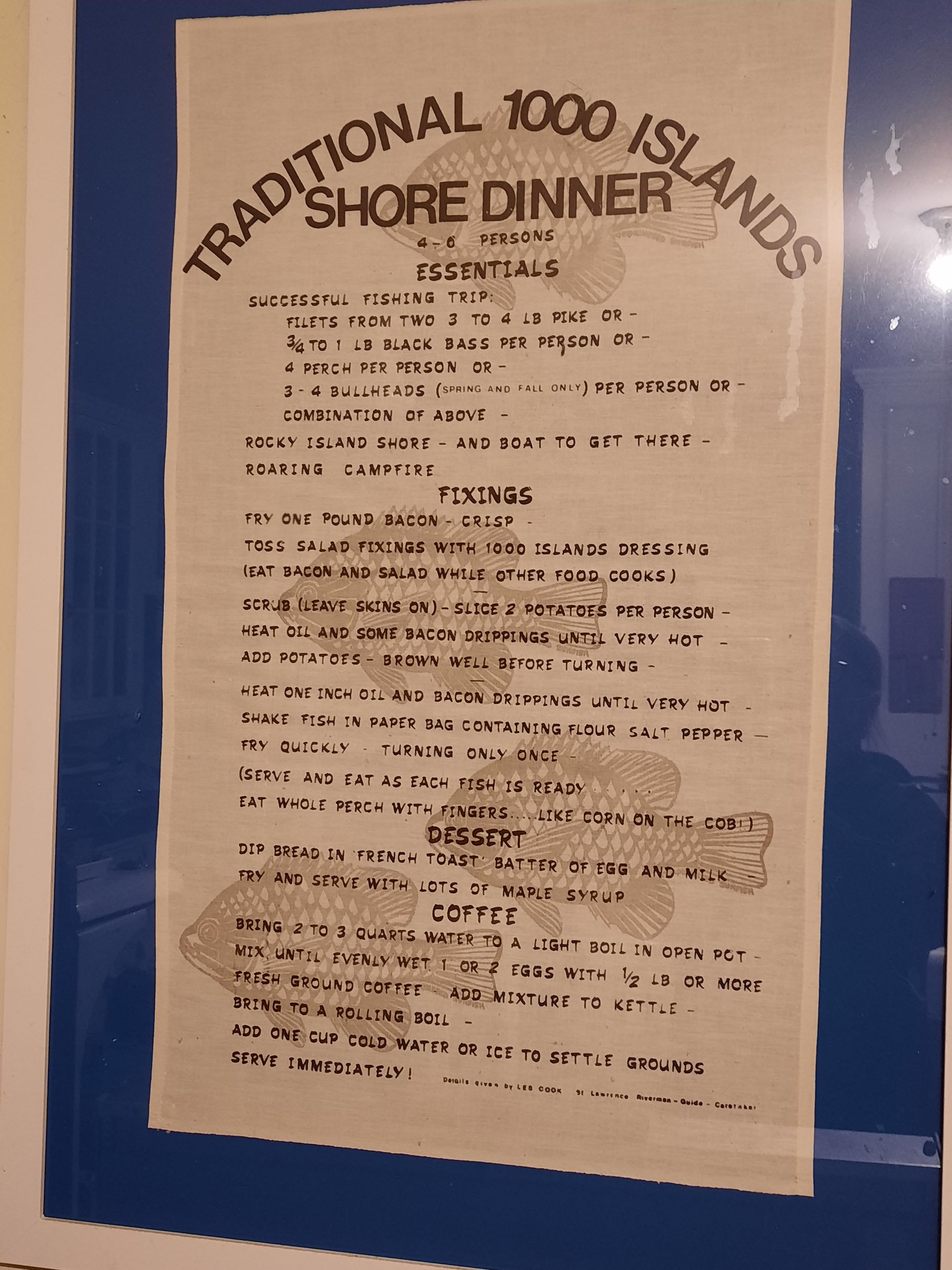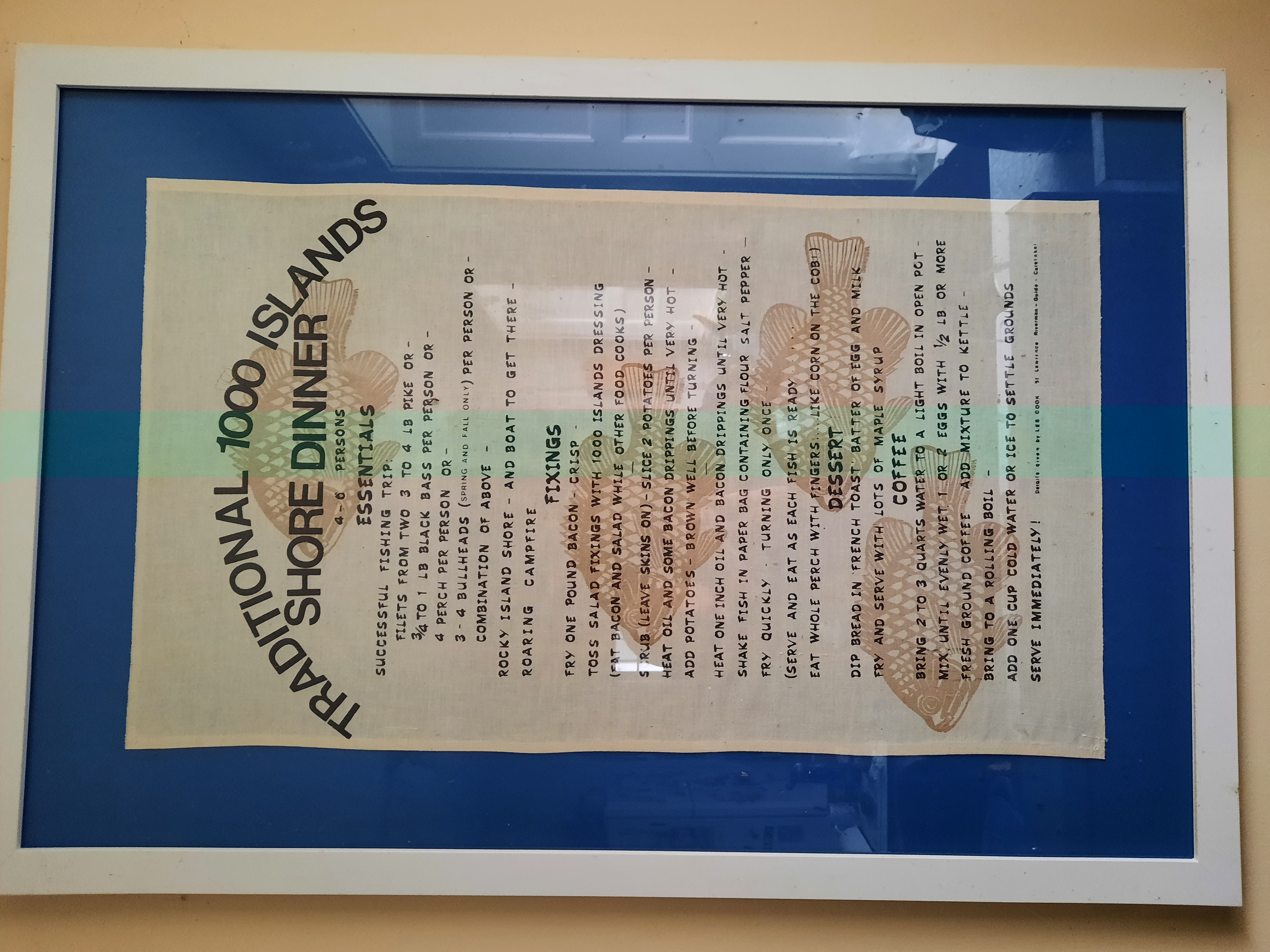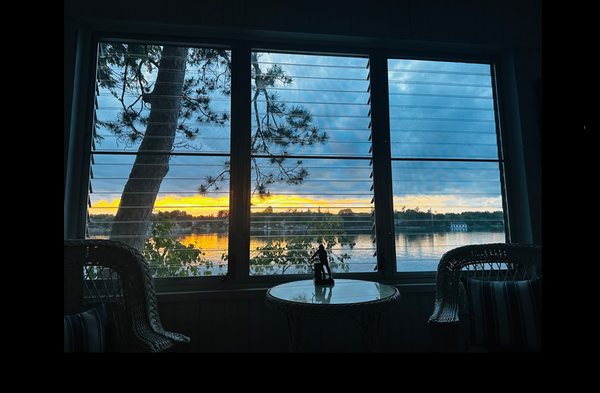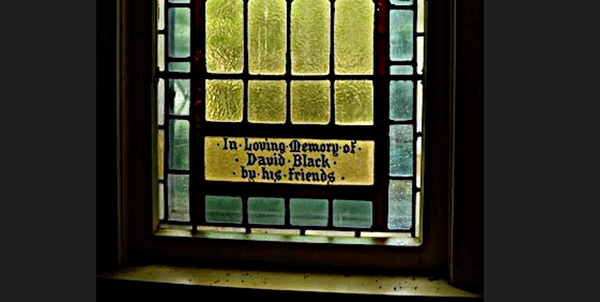River Recipes Please + One!
by: Elspeth Naismith
For years, there’s been a framed tea towel hanging in my kitchen, entitled “Traditional 1000 Islands Shore Dinner,” as told by Les Cook, a local fishing guide. The tea towels were made by the late Kathy Shine.
I’ve never experienced such a dinner, but I really like the idea. It also got me thinking . . .

In this area, we have such an abundance of foods; local farmers; folks who raise bees for honey or who make preserves; lots of fish; ducks, deer, and moose for those who hunt; most people have a patch of ground or a bunch of pots for growing flowers or vegetables or herbs; fruit trees; foraging for mushrooms and other wild edibles – for those who know where and for what to look. We have many different local farmers markets, some of which are open year round.
We also have a variety of people – those who live here year round, those who are summer residents, those who visit from far away, and those who then come back every year or so, just to see what’s new.
With all of this abundance and all of these people, surely there must be some particular foods some particular recipe(s), that are special to this place.
Therefore, Thousand Islands Life is asking our readers to share their favourite River recipe with us. Tell us about the recipe, why it’s special, and why it reminds you of the River. Is it something that you only make at a specific time of the year? Is it a dish that you only make when you’re on the River?
As an example, I have given you my recipe for Sautéed Puffballs. Enjoy and send us your recipe throughout the winter and we’ll review and start publishing them in our 2024 issues. Please make sure that you include any attributions, including the source of the recipe. Yes, both your own ingenuity and Great-Aunt Martha are sources!
River Recipes
Please note – I am not an expert, so please do your own research. I’ve included two research links below, but neither I nor TI Life are responsible for an inadvertently picked poisonous fungus!

Sautéed Puffballs submitted by Elspeth Naismith
Puffballs of all sizes, from an inch to a foot or more in diameter, grow in the St. Lawrence River area, usually during July and August. I’ve seen them growing in fields and on the edges of wooded areas for most of my life. I have eaten them – ones that I’ve purchased from a local market. It wasn’t until the summer of 2023, however, that along with some friends, we actually picked one, prepared it, and then had it with dinner.
If you are, as was I, a little leery of picking a puffball and eating it, here is what we did.
We started by confirming that it was in fact a puffball and that it was edible. There are fungi with a similar appearance, that are either inedible or poisonous, so it’s important to make sure that what you have is safe to eat. How do you do that? Well, we did our research – thank you, Ms. Google!
It’s really quite simple.
What does the exterior look like? It should be pure white. If it’s brown, even if it is a puffball, it’s probably too old to eat. It should also be smooth in texture, although apparently there are some with a rough surface.
Does it have gills? If it does, it’s not a puffball. Discard it!
What colour is the interior? Cut the puffball in half, from top to bottom. The interior must be pure white smooth flesh, with the texture and appearance of a marshmallow or fresh mozzarella.
Note that the button or egg-stage of poisonous gilled mushrooms can look like puffballs – until you slice them vertically, revealing the future stem and cap of the Amanita mushroom in cross-section. Other mushrooms might be a purple colour, which also means that it’s a non-edible fungus.
Does it have a thin, tough exterior coat or layer? If yes, and it peels off (fairly) easily, then it’s a puffball.
Here are a couple of web links to start off your research! Or . . . you can take the easy way and go to the Kingston Farmers’ Market in July and August, to see if any of the vendors are selling puffballs!
https://www.nps.gov/articles/species-spotlight-puffballs.htm
https://www.mushroom-appreciation.com/puffball-mushrooms.html
However you obtain your puffball, here are some ideas for what to do with it.
1. Slice the puffball in half, vertically.
2. Cut each half into 3/4 – 1 inch slices.
3. Peel off the exterior layer or coating. It should be tough, fibrous, and about the thickness of an egg shell, but should peel off fairly easily. You can try to peel each half before slicing, but I found it easier just to peel the slices.
The thing about puffballs is that they’re the tofu of the fungus world. Not much flavour . . . Pretty bland . . . So here comes the fun part . . .
4. Season the slices either before or as you’re sautéing them. What is used to season them is entirely up to you! Simple salt and pepper, or something spicy like creole seasoning, or za’atar, or . . .
5. Heat a frying pan until it’s very hot – I recommend using a cast iron pan – then add a bit of olive oil or butter (or a bit of each), just enough to lightly coat the pan.
6. Gently place a few slices of puffball in the pan and let them brown. Don’t try to crowd in too many slices or they’ll steam instead of browning. Cook for 1 – 2 minutes or until lightly browned, then flip the slices, and cook on the second side.
7. If not already seasoned, drizzle the slices with Tamari (essentially a soy sauce made without wheat), soy sauce, a hot sauce, or a sprinkling of whatever herbs and spices you like. Serve hot.
I haven’t tried marinating the slices before cooking, or baking them in a sauce, but I’m sure that either one could work. Although we haven’t tried it (yet), I’ve read that good thick slices (at least 1 inch thick) can be grilled on the BBQ. But these are all future culinary adventures!
If you have cooked puffballs, please let us know how you do them!
By Elspeth Naismith
Elspeth Naismith grew up in Gananoque, graduated from McMaster University in Hamilton (B.Sc Bio)), and then from Centennial College as a Registered Nurse. She also joined the Naval Reserve (thanks to a Gananoque high school chum), and after spending time on both of Canada's east and west coasts, she took a break from nursing and accepted a 3-year posting to National Defence Headquarters in Ottawa. The "break" turned into 25 years, and included jaunts to East Germany, Wales and the Irish Sea, and Bosnia. Although she is now retired, she is working many hours as the much appreciated, TI Life Real Editor!
[Illustration by Marie-Anne Erki, ©2023, Kingston, ON]
Editor's Note: One of the perks of having Elspeth as our Real Editor, is not only getting our grammar corrected, but each phone call ends with my saying, "What are you cooking today?" There is always an answer that makes me hungry and envious.
Please do send us your favourite River food recipe!






Please click here if you are unable to post your comment.